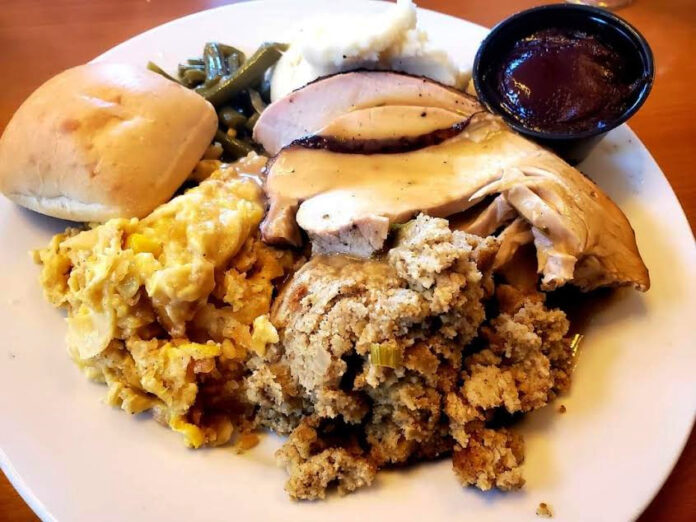The warring factions here pit Southern traditions and tastes against that of our Northern counterparts. It’s an old story, and concessions are not expected anytime soon, if ever. You can probably guess which camp South Carolina falls in line with. But we’re not itching for a fight—nope, not at all! Let all contentions be laid to rest for the sake of national unity.
With our commitment to peace firmly stated, let’s do some friendly examining of reasons why cornbread dressing is so deeply ingrained in Southern foodways and as much a part of our culture as grits or biscuits.
And if you’re a stuffing lover who happens to come away with a new appreciation for the superiority of dressing, well, let’s just call it collateral damage.
Kush in the South was born from the ingenuity of enslaved West Africans, who would take day-old cornbread (as a couscous substitute), mix it with onions, herbs and spices, then fry the concoction in a skillet to make a delicious cornbread hash. Twitty calls it the “grandmother” of Southern cornbread dressing.
As with so many dishes, the contributions of African Americans to Southern food culture cannot be overstated. Next time you take a mouthful of savory cornbread dressing, think about African American heritage and pause to remember those responsible for so many of our favorite dishes.
The ingredients are simple: day-old cornbread, celery, onion, butter, poultry stock, herbs (sage, thyme, rosemary and any others you prefer), egg and salt and pepper to taste. Some cooks add stale biscuits or white bread to the mix. The celery and onion are sauteed in butter, then added to the crumbled bread. Herbs and spices are folded in, along with a beaten egg and enough stock to achieve a somewhat soupy consistency similar to pancake batter.
Protein-wise, oysters are favored as a cornbread dressing ingredient in Charleston and the Lowcountry, while Florence and the Pee Dee tend to throw some country sausage in the mix. Gullah traditions are kept alive by cooks like Daufuskie Island’s Sallie Ann Robinson, who makes a strong argument for the addition of chopped hard-boiled eggs and even bacon to the cornbread dressing. And don’t forget the giblets, which can land directly in the dressing or the gravy that goes on top.
But here’s the real beauty of cornbread dressing: While Northern cooks are busy shoveling stuffing into the poultry carcass, Southern cooks are pouring batter into a greased baking dish, popping it in the oven and taking a sweet tea break for a half-hour or so, depending on how much dressing they’re preparing. There’s no wrestling the raw bird, no fretting over overstuffing it and no worries about possible food poisoning from undercooked stuffing.
There are few things that tempt the Southern taste bud more than a savory wedge of cornbread hot from the oven. Not only is the rustic, grainy texture satisfying, but that definitive corn flavor mingling with melted butter and the slight tang of buttermilk is a melt-in-your-mouth experience that goes well with all Southern dishes.
In fact, you can pair your cornbread with a side of collard greens, peas and beans – or both – and have a completely acceptable and filling meal—no meat required. The same could be said for cornbread dressing, which can tastily anchor a meal made up of nothing more than a turkey wing and a little gravy.
Article originally written by Libby Wiersema and our friends at Discover South Carolina.
Read the full article here.










